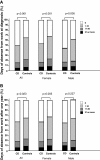Use of health care services and pharmaceutical agents in coeliac disease: a prospective nationwide study
- PMID: 23016889
- PMCID: PMC3503835
- DOI: 10.1186/1471-230X-12-136
Use of health care services and pharmaceutical agents in coeliac disease: a prospective nationwide study
Abstract
Background: Approximately 1% of the population suffer from coeliac disease. However, the disease is heavily underdiagnosed. Unexplained symptoms may lead to incremented medical consultations and productivity losses. The aim here was to estimate the possible concealed burden of untreated coeliac disease and the effects of a gluten-free diet.
Methods: A nationwide cohort of 700 newly detected adult coeliac patients were prospectively evaluated. Health care service use and sickness absence from work during the year before diagnosis were compared with those in the general population; the data obtained from an earlier study. Additionally, the effect of one year on dietary treatment on the aforementioned parameters and on consumption of pharmaceutical agents was assessed.
Results: Untreated coeliac patients used primary health care services more frequently than the general population. On a gluten-free diet, visits to primary care decreased significantly from a mean 3.6 to 2.3. The consumption of medicines for dyspepsia (from 3.7 to 2.4 pills/month) and painkillers (6.8-5.5 pills/month) and the number of antibiotic courses (0.6-0.5 prescriptions/year) was reduced. There were no changes in hospitalizations, outpatient visits to secondary and tertiary care, use of other medical services, or sickness absence, but the consumption of nutritional supplements increased on treatment.
Conclusions: Coeliac disease was associated with excessive health care service use and consumption of drugs before diagnosis. Dietary treatment resulted in a diminished burden to the health care system and lower use of on-demand medicines and antibiotic treatment. The results support an augmented diagnostic approach to reduce underdiagnosis of coeliac disease.
Trial registration: ClinicalTrials.gov NCT01145287.
Figures


References
-
- Vilppula A, Kaukinen K, Luostarinen L, Vilppula A, Kaukinen K, Luostarinen L, Krekelä I, Patrikainen H, Valve R, Mäki M, Collin P. Increasing prevalence and high incidence of celiac disease in elderly people: a population-based study. BMC Gastroenterol. 2009;9:49. doi: 10.1186/1471-230X-9-49. - DOI - PMC - PubMed
-
- Rampertab SD, Pooran N, Brar P, Singh P, Green PH. Trends in the presentation of celiac disease. Am J Med. 2006;119(335):e9–e14. - PubMed
Publication types
MeSH terms
Substances
Associated data
LinkOut - more resources
Full Text Sources
Medical

